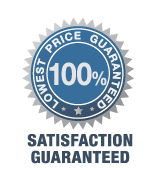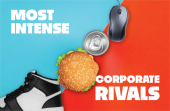How to Personalize a Promotional Product

We felt the question mark image was a good way to set the tone for this article because we're sure that if you're reading this, you have a lot of questions. How do you design a promotional product? Which custom logo imprinting method is best? What is the difference between screen printing and full-color logo imprinting? Why do they call it 4 color process printing? These and many others are sure to be among your burning questions, and we'll answer each and every one of them for you right here.
The personalization of a promotional product is beyond a doubt the #1 most essential aspect toward the success or failure of said product. After all, if it's not closely tied to your brand and doesn't present your logo, how is it going to spread brand awareness? In most cases, it won't. That's why it's so important to learn the best ways to personalize promotional products for customers, employees, and anyone else to whom you wish to market. We're going to cover the ten best and most commonly used methods in this article, as well as fill you in on the strengths and weaknesses of each method. It's our goal to empower you to make the best promotional personalization choices possible to take your company branding efforts up to the next level!

In the event that you're curious about one particular method, we're putting together this menu that will link you to each individual promotional item personalization method we're going to cover. We suggest reading them all though, as this will provide you with the most information and allow you to make the best possible choices in your future promotional efforts. We're going to conclude with an all-inclusive table to recap the key points covered in this article.
- What is Screen Printing?
- What is Full Color Printing?
- What is Pad Printing?
- What is Hot Foil Stamping?
- What is Embroidery?
- What is Embossing?
- What is Debossing?
- What is Laser Engraving?
- What is Sandblast Etching?
- What is Dye Sublimation?
What is Screen Printing?
Just what is screen printing? Screen printing is the process of transferring a design onto a given item through the use of pre-cut stencils through which colored ink is poured and swept. This transfers the ink to a predetermined location on the item to be decorated, adding color to its stenciled design. As some of these stencils are made of silk, the term "silkscreening" is sometimes used. Screen printing is one of the lowest-cost methods of designing promotional products and therefore it's great for promotional items that are ordered in large quantities. It's also quite handy for items that have only one color in their logo design, as most other methods would end up costing more without being any more effective. Note that this is usually the case, but it's not always the case.
Screen printing works well for minimalist-style logos and ones that possess relatively simple designs. Below are images of two of our screen-printed promotional products. One is our Poly Pro promotional screen-printed tote bag, and the other is our custom screen-printed lanyard in 3/4 inch size.


As can be seen, both of these items have relatively simple designs. The monochromatic design of the tote bag and the simple multiple color step & repeat style imprints on the lanyards are best rendered via screen printing. Screen printing promotional items does have its shortcomings though. Since a different screen needs to be cut for every ink color added to a product, it's not a great pick for items with very colorful or highly elaborate designs.
Below is a video that shows the screen printing process and how it all works while adding a personalized logo design to a branded tote bag. The video is courtesy of Catspit Productions (opens in a new window), a Phoenix, Arizona-based producer of quality screen printing supplies.
What is Full Color Printing?
Full-color imprinting can be done in a variety of ways and is known by quite a few different names. You may hear it being referred to as heat transfer printing, 4-color process printing, photographic reproduction, dye sublimation, and any number of different brand names. While photographic reproduction and dye sublimation are names that are sometimes used to refer to the full color printing process, they aren't technically correct as they refer to different decoration methods that we'll get to a bit later on. Heat transfer printing can be broken down into vinyl and digital methods. With vinyl, designs are cut from vinyl material and then transferred onto the promotional product using a heat press. With digital heat transfer printing, a solvent ink goes on a special kind of heat transfer paper that is then passed on to the item to be decorated in a heat press.
The name 4 Color Process comes from the fact that four colors of ink - magenta, cyan, yellow, and black - are blended together to create almost any other imaginable color on the spectrum. The pre-made design is printed our four times, each in one of these 4 colors. They're then transferred to printing press plates where they're transferred and applied to an item one by one. PMS color matching, short for Pantone Matching System, is a printing method by which every shade of every color is given a numerical value, and then matched exactly by specialized printers. This is sometimes referred to as photographic reproduction.


The benefits of using full-color imprinting on your promotional products are many. They allow for more elaborate designs, bolder colors for a stronger visual impression, and much faster production cycle times as compared to screen printing. However, it is more expensive and a somewhat less viable option for extra large orders or for logo designs that only possess a few colors in a simple layout. As can be seen above, our promotional recycled tote bags with full color logo imprints and our customized full-color printed lanyards have very bold, emphasized logo designs that immediately catch the eye. These are items whose logo designs are color-intensive and rely heavily on immediate aesthetic appeal, making them prime candidates for this style of logo personalization. Just below this paragraph is a video that shows you a bit about how full color promotional products are made. This video is from Heat Press Nation (opens in a new window), a producer of high-quality printing equipment based in Fullerton, California.
What is Pad Printing?
The next promotional product personalization method we'll get into is pad printing. Pad printing is similar ways to screen printing, at least when it comes to the final product. However, the process is quite a bit different and is needed in different situations. For example, there are some items whose shape and material make them very difficult to decorate by way of screen printing. Many plastic, rubber, and metal items fall into this category, as do items that are curvy and/or don't conform to a typical polygon format. This process involves specialized metal dies being created in the shape of your desired logo design, which are then coated in ink. These dies then stamp the ink into a receiving surface, which is then stamped by a soft silicone pad. The silicone pad then takes on the ink design in reverse, before being pressed down onto the promotional product being manufactured. The design is then transferred onto the item, facing in the correct position.
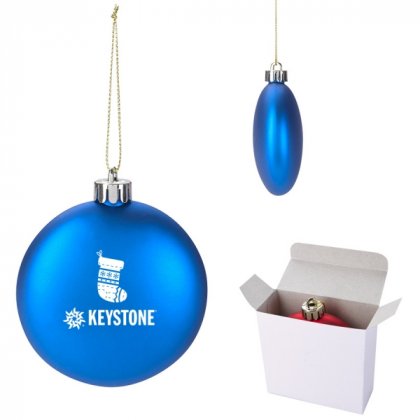
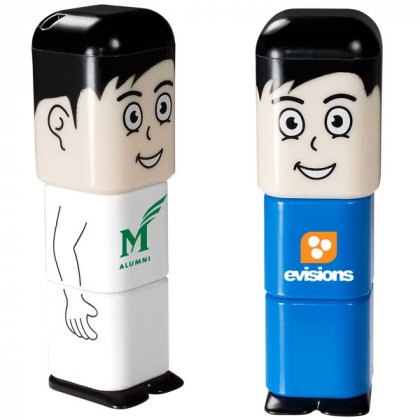
The two items pictured above have both been decorated via pad printing. Our promotional flat boxed round ornaments and Power Buddy promotional power banks with pad-printed logo designs are both able to be designed perfectly despite their odd surfaces due to the pad-printing process. Some additional benefits of pad printing include higher-resolution images that are executed with a higher level of detail than what is possible with screen printing. The downside is that this method is more expensive, has a slower production time (than full-color imprinting), and doesn't allow for quite the same level of color opacity of screen printing.
Take a look at the video below and learn how the pad printing process for promotional products goes from start to finish. The credit for this video goes to Nazdar Ink Technologies (opens in a new window), a Shawnee, Kansas-based purveyor of printers, ink, and software.
What is Hot Foil Stamping?
Foil stamping is another process that has many monikers. Foil stamping, hot foil stamping, heat stamping, hot stamping, and foil heat stamping are just a few of the most common terms you'll hear used, all of which refer to the same thing. Hot foil stamping is a promotional product decoration method that is most often seen with envelopes for custom-designed greeting cards, promotional presentation folders, and most any other business promotional product that goes for an air of professionalism, sophistication, and formality. The process is essentially carried out by creating metal dies in the shape of the pre-conceived design that are held by a press above a roll of decorative film. The press sends the die down into the film, which in turn is pressed down on the surface of the promotional item below. The high levels of heat cause the designs on the roll of foil film to be transferred onto the desired item, giving it a 3 dimensional and very professional-looking custom logo imprint. Typically, this will be either silver or gold in color.
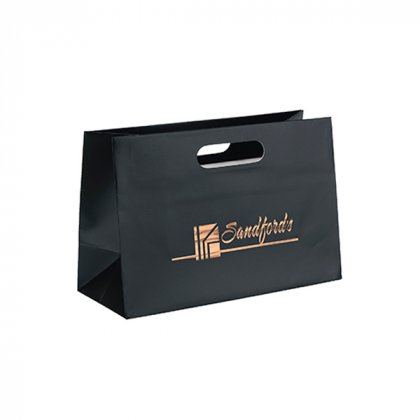

The picture on the left is the Olivia Matte Laminated Bag, which is one of our most popular laminated recycled tote bags. On the right are our custom hot foil stamped 1/2" ring binders. As you can see, when you design your own promotional items via hot foil stamping, you're treated to a product with a 3 dimensional print with an air that managed to be both professional and festive at the same time. These are especially good for company seals or anything that might be used in a legal context. As with any custom personalization method, hot foil stamping does have its limitations and downfalls. It's not a good pick for designs with multiple colors, it can become a bit pricey on large orders, and it requires a relatively smooth surface to be executed properly.
Curious to learn more? Take a look at the video below that gives a visual insight into how hot foil stamping is done. Credit for the video goes to YouTube user LC Printing Machine Factory Limited.
What is Embroidery?
The next method for personalizing promotional products that we'd like to share with you is embroidery. Embroidery involves the sewing of intricate designs onto the surface of a product. It helps to give items a 3-dimensional logo that stands out and can run the gamut from quaint to bold. Embroidered promotional products can offer a classic homespun look and are also excellent when it comes to creating a powerful sense of contrast between your personalized logo design and the rest of the fabric it's being applied to.

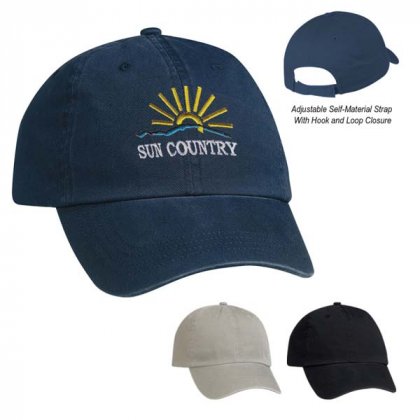
If you'd like to see examples of what some of our embroidered promotional products look like, just take a look at the two items pictured above. On the left is one of our custom embroidered sherpa blankets, and on the right is one of our promotional embroidered chino caps. As you can see, the embroidered logos provide a sharp contrast to the body of the items they decorate and rise up for a 3 dimensional effect. When designing your own promotional stadium blankets, caps, aprons, or apparel, you'll want to pay attention to thread counts and available colors to make sure the right thickness and hues for your logo are available. If they aren't, embroidery might not be the way to go. This is a decoration method that won't fade or chip with time, but it does have a long production process, can be costly, and is limited in regard to the range of materials to which it can be applied.
If you want to get something embroidered, you may want to watch the following video. It shows the process of embroidering a promotional cap. It comes courtesy of Stackamillion (opens in a new window), a UK-based hip-hop clothing company that bills itself "an authentic clothing brand for the believers."
What is Embossing
Next up is debossing. When you've decided you want to design your own promotional products, you'll sometimes find that a three-dimensional look is what suits your logo best. However, with some materials, embroidery and foil stamping aren't viable options. When you want to create a three-dimensional design with such an item, embossing is often an excellent choice. Basically, embossing is a process by which portions of the surface of an item are raised up or have a multidimensional look. Once achieved, they can be further personalized through the addition of ink or paint, but also might look good standing alone. The risen surface gives embossed promotional products an aggressive, high-energy look and can allow a company to emphasize its logo without betraying its design through the addition of extra, ill-fitting colors.
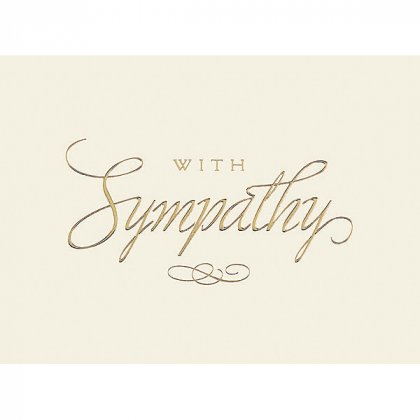
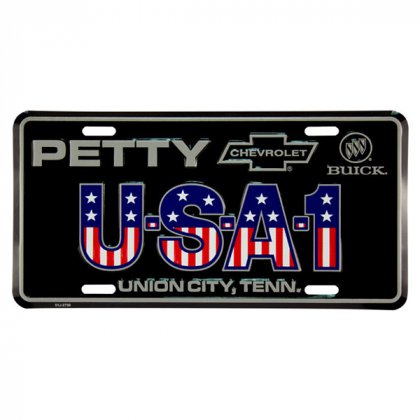
The images above show the effects of embossing on our promotional corporate greeting cards and personalized license plates. As can be observed, their surfaces are raised up to emphasize the designs they carry in a more prominent manner. Embossing products does have its limits though. Due to it being an off-press design method, it has a longer production schedule than most other logo design processes and can be more costly, both due to production schedules and the cost of the machinery used to create the designs.
Below is a video that illustrates the process of custom logo embossing on a silicone surface. Credit for the video goes to Sollyd (opens in a new window), a Chinese chemical company that manufactures chemicals, silicone, and ink needed for the production of personalized logo promotional items.
What is Debossing?
While they may sound quite similar, embossing and debossing are designed to achieve the exact opposite ends. While embossing creates a raised surface, debossing creates a depression within a product's surface to brand its logo design permanently within a piece of material. This is a process most commonly seen with leather and faux leather items but is hardly limited to just those mediums. The inverted version of the logo makes it more durable, as mishaps won't be able to depress or crack the created designs. It also ensures a customized logo personalized product that will never fade over time, making it highly popular for personalized gifts and heirloom-style items. Many of our wedding gifts, particularly our promotional drinking flasks, are decorated by way of debossing.
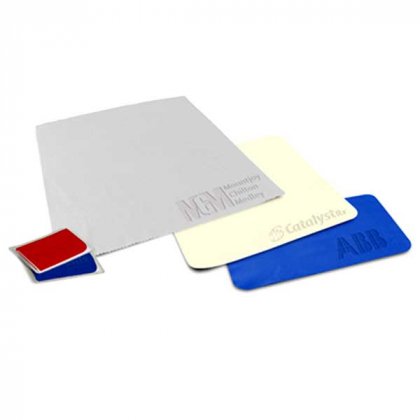
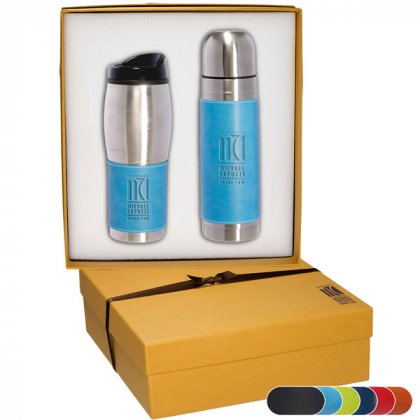
On the right, you can see our personalized Thermos® & tumbler gift box set, which features debossed logo imprints on the blue leather sleeves around the tumbler and Thermos®. To the left, you'll see our wholesale microfiber cleaning cloths, which prove our earlier point about this method not being exclusively for the leather and leatherette families. When it comes to the limitations of debossing (and embossing vs debossing as a whole), there are a few things to consider. Some see it as being an understated design method with a bit of a passive look. Otherwise, it doesn't have many downsides other than the fact that it's a method that can't be used on some materials, such as most metals and plastics.
If you'd like to see how debossing works, the following video will grant your wish. This video comes courtesy of Swag-Journal (opens in a new window), a publication dedicated to exhibiting the diversity and contributions of different artists in many fields throughout the world.
What is Laser Engraving?
When you're looking to design your own personalized corporate gifts, laser engraving is often a great method to choose. It allows designs to be cut into the surfaces of metal items in a way that creates a long-lasting and high-quality logo design that will always withstand the test of time. It is achieved by way of using the heat from laser beams to penetrate the surface of metals, creating a visible depression. While it is most frequently used on metal items, it can also be applied to rubber and plastic. Many of our personalized corporate award gifts and promotional stainless steel water bottles with low minimum orders are designed this way. We have many great laser-engraved gift ideas for you to select from.


Pictured above are two of our items that have been decorated by way of laser engraving. On the left is one of our promotional engraved stainless steel growlers, and on the right is one of our personalized engraved stainless steel dog tags. Both of these are low minimum order items, so each one can be custom-designed to be specially created for each individual recipient. While laser engraving is an excellent method for designing your promotional products, it does have a few weaknesses. It can't cut very deeply into some metal items, nor can it cut as evenly on glass as compared to sandblasting.
Below you can observe the laser engraving process as it is applied to dog tags, in a video made by Trotec Canada (opens in a new window), a company that produces laser engraving machines.
What is Sandblast Etching?
Sandblasting is another promotional product personalization method that is referred to by more than one name. Some call it sandblasting, while others use the terms "sandblast etching", "sandblast engraving", "sandblasted etching", or just plain "etching". In any case, it refers to a process in which glass items that have been fitted with protective film coatings are "blasted" at very high levels of pressure with a combination of sand and air. This is typically done inside of a specialized booth, with a stencil overlay in place so that the correct items will be etched into the surface of the glass. Many of our promotional beer glasses, custom promotional wine glasses, and personalized shot glasses are decorated using this method.
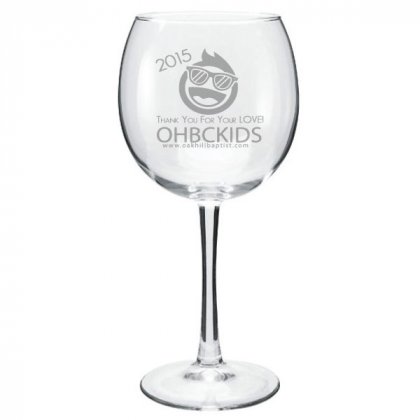

As can be observed in the custom sandblasted wine glass and promotional sandblast etched mason jar beer mug pictured above, sandblasting is able to create deep, consistent cuts in glass for a three-dimensional, built-in design that won't chip, fade, or deteriorate over time. If you want to create promotional glassware that will be around for decades and then some, sandblasting is the way to go.
As is the case with every method that we've discussed so far, sandblasting has its own set of strengths and weaknesses. While we've pretty well covered its strengths, we should mention that in terms of weaknesses, it can't be used to create colored designs, can be rather costly, and will create a frosted look in glasses that are already colored, rather than conforming to the color of the rest of the glass.
If you'd like to see how the sandblast etching process works, take a look at the video below. It was shot by Cincinnati-based Gearbox Designs (opens in a new window), a company that specializes in creating keepsake items based on the themes of classic horror and pulp film characters.
What is Dye Sublimation?
The last promotional product personalization method we'll discuss today is dye sublimation. When you want an extremely colorful design that covers the entire surface of an item, this needs to be your go-to method. It allows for fully customized products with photographic quality. For all of this to take place, an item needs to enter into a sublimation printer. Within this device, dry inks are transferred to items through extreme levels of heat. Solid inks move to a gas stage in the transfer process, skipping the liquid state of matter. The scientific term for this is "sublimation" and that's where this decoration technique gets its name from. It creates prints that won't crack, fade, or peel over time and also allows for the inclusion of extremely detail-rich logo designs. Many of our promotional aprons and custom felt pennants are designed this way.
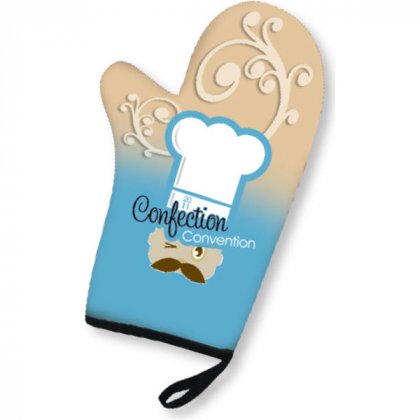
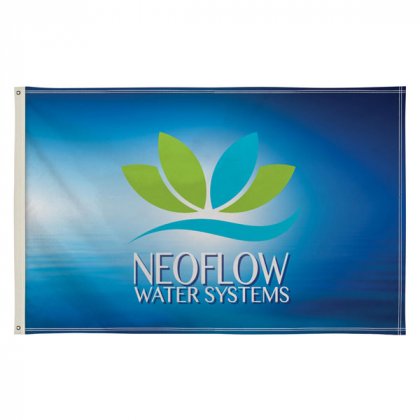
Two examples of dye sublimation in promotional business products include our custom dye sublimated oven mitts & our promotional dye-sublimated business advertising flags. As can be plainly seen, these items play host to extremely bright, vibrant, detailed, and full bleed artwork designs that make them impossible to ignore. On the downside, dye sublimation tends to have longer production times than most other traditional logo imprinting methods and older printers sometimes have trouble pulling the job off when orders are made in especially large volumes. We offer many blank dye sublimation promotional products that you can fully customize in nearly any way you wish.
If you'd like to see how a promotional product is dye-sublimated, you can view the video below this paragraph. It was shot by Sky Image, a China-based supplier of sublimation process papers & inks.
As promised earlier, here's the condensed version of the strengths and weaknesses of all of the different ways in which you can personalize a promotional product.
| Business Logo Personalization Method | Advantages | Disadvantages | Best Uses |
|---|---|---|---|
| Screen Printing | Affordable, Great for High Volume Orders & Minimalist Designs, Optimum Color Opacity | Slower Production Times, Less Detailed Designs, Fewer Colors per Design | Large Order Volumes, Logos with Simple Designs, Logos with Minimalist Designs |
| Full Color Printing | Bold Colors, More Detailed Designs, Fast Production Times, PMS Matching Available | More Expensive than Screen Printing, Less Useful for Single Color Prints | Intricate Logo Designs, Items with Bright Colors, Multiple Color Logo Designs, Small Orders |
| Pad Printing | Can be Used on Surfaces that Won't Take Screen Printing, High Resolution Image Quality | Less Color Opacity, Longer Production Time, and Higher Cost Compared to Screen Printing | Decorating Items Made from Rubber & Plastic, Creating Logo Designs with Few Colors yet High Resolution Needed |
| Hot Foil Stamping | Formal & Professional Look, 3-Dimensional Effect | Use is Limited to Smooth Surface Materials, Time Consuming, Costly in Large Volumes | Envelopes, Legal Documents, Portfolios, Ring Binders & Items with Smooth Surfaces |
| Embroidery | 3-Dimensional, Homespun Look, High Contrast, Will Not Chip or Fade | Limited Choice of Colors, Longer Production Times, Not Possible on Many Materials | Decorating Stadium Blankets, Picnic Blankets, Caps, Hats, Aprons & Nearly Any Apparel or Linen Product |
| Embossing | Raised Surface, Aggressive Appearance, Embellishment without Betraying Logo Colors | Higher Costs & Longer Production Times Due to Off-Press Nature of Process | Creating Raised Logo Designs on Paper Products, Silicone Items & Personalized License Plates |
| Debossing | 3-Dimensional Inverted Design Potential, Fade & Crack Resistant, Durable Designs | Can Sometimes Look Passive & Understated | Creating Logo Designs for Leather & Faux Leather Items, Decorating Promotional Microfiber Items |
| Laser Engraving | Creates Permanent Designs in Metal, Low Minimum Orders, Quick Production Times | Cannot Cut Deeply into Most Surfaces, Less Even Cuts in Glass as Compared to Sandblasting | Decorating Personalized Jewelry, Promotional Stainless Steel Water Bottles, Flasks, Dog Tags & Awards |
| Sandblast Etching | Deep Even Cuts in Glass, Creates Elaborate & Durable Designs | Labor Intensive, Slower Production than Laser Engraving, Cannot Be Done in Color | Creating Logo Designs for Promotional Beer Glasses, Promotional Wine Glasses, Shot Glasses, Glass Ornaments & Personalized Glassware |
| Dye Sublimation | Fully Customized Surface Designs, Photographic Quality Images, Most Elaborate Designs | Higher Costs Due to Production Times & Machinery Used, Poor Fit for Simple Designs | Creating Fully Customized Apparel & Banners, Bringing Intricate Designs to Life, Best Way to Show off Colorful & Detailed Artwork |
Want a more visual depiction? Try this infographic on for size:

Now that you've become a certified promotional product personalization pro, you'll have the knowledge and power needed to make the best decisions when it comes to designing promotional items for your business. Remember that every technique has its time and place, and no one can truly be said to be inherently better than the others. These are your products to design and they'll be another aspect of the face of your business that the public sees on a daily basis. A superior product will always be produced when time, care, patience, and deliberation are used to arrive at the best decisions. Above all, remain enthusiastic and have fun! Chances are, if you enjoy creating a product, the public will enjoy using it. Refer back to this article whenever you need to and get out there and start designing personalized promotional products that will make your promotional dreams come true!

